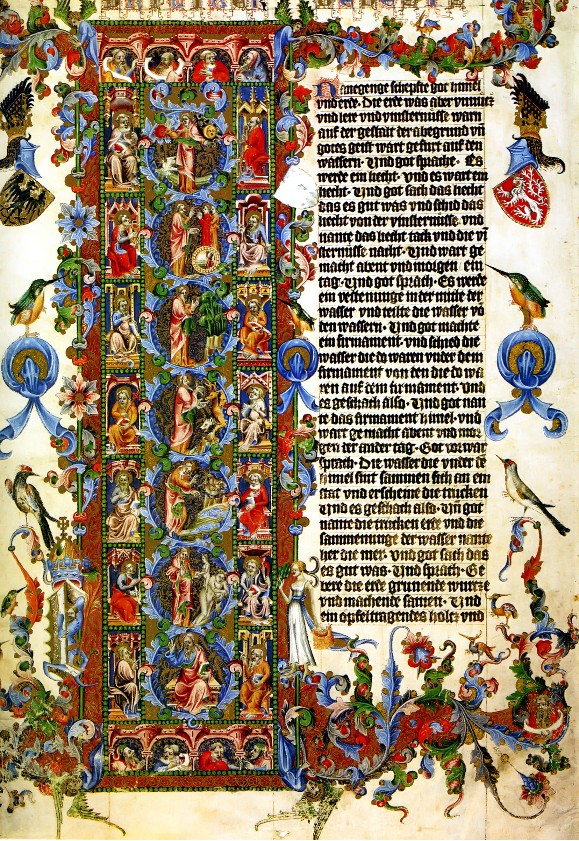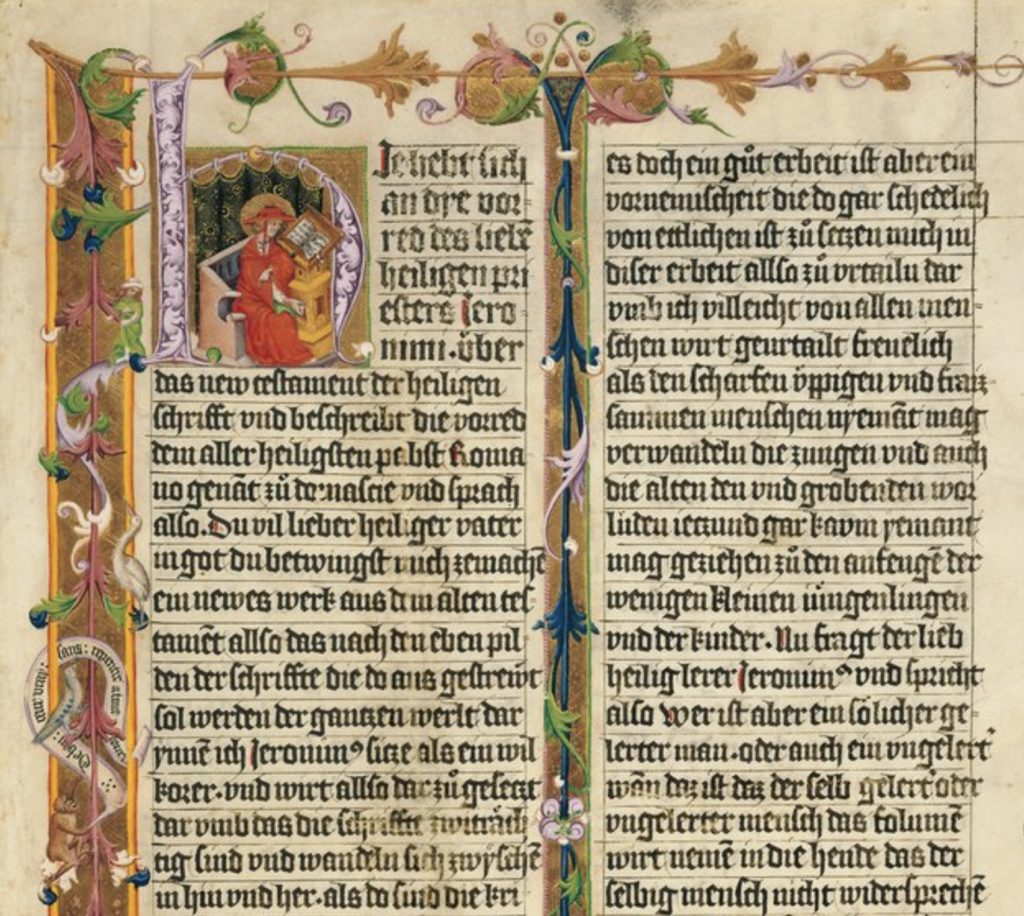In his 1479 printed Beichtspiegel (Mirror for Confession), lay barber and Meistersinger Han Folz of Nuremberg used rhyming verse to teach his readers about the triangle of rew, beicht, buß (contrition, confession, penance); the dangers of purgatory; and above all, the seemingly endless numerical lists of vices and virtues that so characterized fifteenth-century religious literature. [1] There was no need to limit oneself to the seven deadly sins and seven cardinal virtues when there were also four sins that cry to heaven (one of which is, however, the silent sin), six sins against the Holy Spirit, and nine alien sins.
By 1479, a wealthy, prominent, and educated burgher like Folz evidently had little to fear from widely disseminating orthodox religious writing in the vernacular to instruct other laity. Indeed, while he printed the original Beichtspiegel himself, the text was later printed in an anthology alongside didactic literature by clerical authors. Nevertheless, the lack of authority of office led him to ground his authority throughout the Beichtspiegel via textual citation. More specifically, via a single type of citation. Folz cites “Levitici am vierundzweinzigisten capitel” (Leviticus 24); he cites “quarto Regum quinto” (4 Kings 5); he cites “Luce sedecimo” (Luke 16). [2] Throughout the entire Beichtspiegel, almost all of his citations take the same form, and without exception they come from the same source: the Bible.

It was not for lack of knowledge of other religious texts. Folz’s Latin was good enough for him to accomplish two different translations of the Life of Adam and Eve, and his immense corpus of surviving poetry, songs, and Carnival plays reveals an extensive familiarity with the more theoretical or theological ideas that lay beneath the “mass market” Christianity of his day. [3] Furthermore, in his medical texts, Folz shows he understands the utility of citing earlier authorities through his references to Galen, Avicenna—and Augustine. [4] In the Beichtspiegel, his decision to rely solely on the Word of God as authority was indeed a decision.
Das wort gottes could be rallying cry of the Reformation because the late Middle Ages got there first. The Bible’s position as the focus of lay arguments in favor of the early Protestant movement, we have long known, was rooted in its already-existing popularity in lay religious life, not its absence. [5] In addition to the enormous amount of [[vernacular biblical material available to lay readers]], pastoral care manuals and priests’ prefaces to Bible translations emphasized the need to make scripture accessible to the laity.
Sandra Corbellini has noted a second important emphasis in pastoral texts encouraging lay Bible use: the act of reading scripture—independent of the specific contents—as an act of peri-mystical devotion reminiscent of monastic meditatio. One of the fifteenth century’s most influential preachers, Bernardino of Siena, preached that “the more you read and study [the Bible], the more sweetness you get, the more you feel the taste of God. If you try it, you will know; otherwise not.” [6]
No matter how rhythmic Folz’s verse (not really at all) or how perfect his rhymes (very imperfect), it is undeniable that his rote lists of sins and virtues put one in the mindset of learning facts, not the prayerful devotion Bernardino suggests. However, popular teaching’s legitimization of the act of reading scripture from the act of learning from reading scripture had its parallel at the more learned level, too.
Ian Christopher Levy’s aptly named Holy Scripture and the Quest for Authority at the End of the Middle Ages shows how the theological debates of the turbulent period between 1370 and 1430 so often turned on the question of who had the authority to determine what constituted a correct—therefore authoritative—interpretation of scripture.[7] The act of correct reading, separate from the interpretation itself, was important enough to be its own flashpoint for debate and worse. The act of reading was inseparable from the determination of authority.

In that light, the specific method by which Folz cites the Bible merits attention. With the exception of a couple of places where Folz refers briefly to a Bible story to illustrate his point, all biblical references take the same full form: book and chapter. (Verses were not regularly numbered and used until far later.) His citations are purposeful citations of the Bible as a book, not just a text.
Folz, moreover, is not the only fifteenth-century German layman to seek this association. 1460s-era lay apocalyptic prophets Livin and Johannes Wirsberger of Egerland were exquisitely aware of the precariousness of their position, given the dark fears of the devil corrupting ignorant lay people into proclaiming false prophecies. Their few surviving letters feature insistent deferrals to the Church as the ultimate judge of true and false messages, but also their authority to write anyway. [8] One favorite tactic? The citation of scripture by book and chapter.
Folz and to some extent the Wirsbergers direct their readers’ attention to the Bible as a book—inseparable from directing readers’ attention to the authors’ familiarity with the Bible as a book. They seem to signal not just their religious knowledge, but the fact that they are able to access it through reading the Bible.
The possibility that religious authority could lie in the act of reading scripture raises questions about the relationship of laity and clergy, and just as importantly, public perception of “clergy” and/versus “lay” in the realm of popular, vernacular religious teaching. In an era filled with das wort gottes and significantly increasing urban literacy rates, further investigation will hopefully help illuminate intersections between contemporary religious culture, benefit of clergy, and—yes—a priesthood of quite a few additional believers.
Cait Stevenson
PhD in History
University of Notre Dame
—
[1] Hans Folz, “Beichtspiegel,” in Hans Folz: Die Reimpaarsprüche, ed. Hanns Fischer (Beck, 1961), 188-210.
[2] Folz, 195 (4 Kings 5); 202 (Leviticus 24);204 (Luke 16).
[3] See, for example, John D. Martin, “Dramatized Disputations: Late Medieval German Dramatizations of Jewish-Christian Religious Disputations, Church Policy, and Local Social Climates,” Medieval Encounters 8, no. 2–3 (2002): 209–27.
[4] Folz, “Pestregimen in Versen,” in Fischer, 412-428; “Pestregimen in Prosa,” in Fischer, 429-437.
[5] Although research on the use of the Bible in German-speaking lands has generally lagged behind studies in other regions, Anthony Gow’s work offers an excellent introduction to the medieval situation as well as briefly touching on earlier scholarly efforts: Gow, “Challenging the Protestant Paradigm: Bible Reading in Lay and Urban Contexts of the Later Middle Ages,” in Scripture and Pluralism: Reading the Bible in the Religiously Plural Worlds of the Middle Ages and Renaissance, ed. Thomas J. Heffernan and Thomas E. Burman (Brill, 2005), 161-191.
[6] Translated in Sandra Corbellini, “Instructing the Soul, Feeding the Spirit, and Awakening the Passion: Holy Writ and Lay Readers in Late Medieval Europe,” in Shaping the Bible in the Reformation: Books, Scholars, and their Readers in the Sixteenth Century, ed. Bruce Gordon and Matthew McLean (Brill, 2012), 24.
[7] Ian Christopher Levy, Holy Scripture and the Quest for Authority at the End of the Middle Ages (University of Notre Dame Press, 2012), xi.
[8] Frances Courtney Kneupper, The Empire at the End of Time: Identity and Reform in Late Medieval German Prophecy (Oxford, 2016), 115, translates: “Thus should you act justly in your reason and take to heart what the lords Matthew in 23, Mark 13, and Luke 21 all say.”






